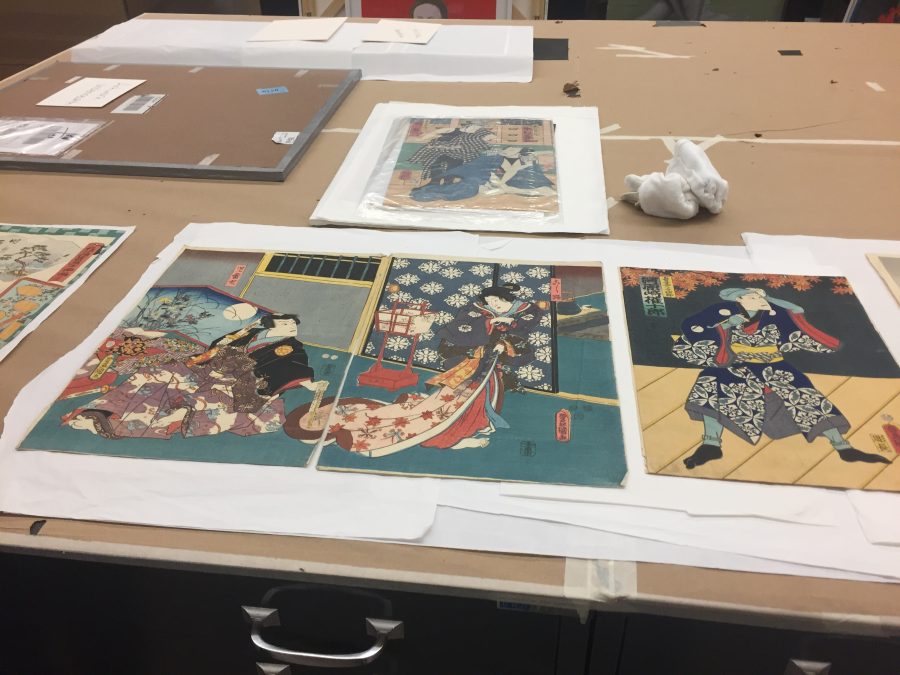The Paul Creative Arts Center (PCAC) is home to a variety of resources, including housing three departments within the College of Liberal Arts (COLA). It also houses the Museum of Art, which, as all museums do, has its own collection of artistic artifacts. The Museum of Art’s collection specializes in a few types of artwork, including Japanese woodblock prints.
Japanese woodblock prints are artistic prints made through an elaborate process. The process begins with an artist drawing an outline of what they what the print to show. The artist then uses this outline to guide multiple carvings of wood blocks, with each block being carved only for a certain color or color gradient—i.e., only the blue portions of the drawing will be carved, while red portions are carved on a different block. These are relief carvings: the artist cuts away the parts of the wood block that are not part of the drawing, akin to a sculptor sculpting rock away. After inking each block, the artist prints, or stamps a thin, almost paper-thin piece of wood with the images, layering them.

The result, as seen by the over 2,000 individual prints the Museum of Art has in its collection housed in the PCAC is an image with clean lines, the grain of the wood printed on visible, and strikingly vibrant, bright colors.
The Museum of Art has acquired such a large collection of prints since 1940, when the collection began, according to Kristina Durocher, the director of the Museum of Art.
“There were two significant collectors,” Durocher, who contributed to and helped build the collection, said, though “up until about 2000, it grew primarily through gifts and bequests.” The University of New Hampshire (UNH) itself has also purchased some pieces.
Many Japanese woodblock prints were produced in the 19th century, but are still made today, and in the 19th century it was a ubiquitous art form in Japan.
“You can imagine what these would have been like in an era where color photography was really just beginning,” Durocher said, although she later noted that the prints had been a long-established art form by the time photography emerged. “These [prints] are very vibrant, very dynamic.”

Prints were produced for a variety of purposes: to commemorate events or nature; to depict local actors; show landscapes; serve as board games; even, illustrate stories. “There’s unlimited subjects that you could collect in for Japanese prints,” Durocher said.
Aside from the actual scene depicted, each print contains several characters providing context for the scene. The characters may even be incorporated into objects within the print, or placed in distinct boxes.
When prints were made, they were often made in a workshop. The multiple steps to create one print were delegated amongst a group of people in the workshop, with the credited artist providing the drawing.
Workshops helped the ubiquity of the prints: “You could produce something very quickly, so they could respond to [for example] a popular actor…they could then produce prints very quickly.” Durocher said.
“[The prints] were produced by the thousands,” Durocher said. Even today, Japanese art catalogs and art dealers’ inventory offer prints for sale. “The way that some of these Japanese prints made their way into Europe…[was that] they were used like newspaper, in packing.”
The collection has served many purposes at UNH. “We have had art historians use them with their students, and then we’ve also had studio faculty members use them as examples of wood block printing,” Durocher said. A fellow from Amherst College’s Mead Art Museum has spoken about Japanese wood prints, and a subset of the prints have been on display in the Museum of Art.
When not in use, the prints are stored flat and in drawers away from light—light fades pigment, which could harm the prints’ vibrancy, Durocher said. To keep the prints wooden sheets of the prints from corroding, “They’re stored in acid free mat boards with tissue covering them to protect them from dust, [which] also protects them from any kind of abrasion.” However, as prints were occasionally mounted onto silk scrolls, these scrolls are stored in the wooden boxes they came in. Each print or scroll is catalogued, and photos of just over 100 are available online.
Students wishing to reference the Japanese woodblock prints should contact Laura Calhoun, the Museum of Art’s exhibitions and collections manager at [email protected]. The Museum of Art also offers fellowship positions, for the entire academic year, for undergraduate students majoring in the Department of Art and Art History. Applications are available in February 2020.






















